White snakeroot
(Ageratina altissima var. altissima)
Conservation • Wetland • Description • Habitat • Ecology • Use • Distribution • Taxonomy
Conservation Status |
|||
IUCN Red List |
not listed |
||
NatureServe |
N5 - Secure SNR - Unranked |
||
Minnesota |
not listed |
||
Wetland Indicator Status |
|||
| Great Plains | UPL - Obligate upland |
||
| Midwest | OBL - Obligate wetland |
||
| Northcentral & Northeast | OBL - Obligate wetland |
||
Description |
White snakeroot is a 1′ to 5′ tall perennial forb that rises on 1 to 3 stems from a rough, knotty, fibrous-rooted rhizome. It grows only in shade. It is a late bloomer, one of the last flowers to be seen in the woods in the fall. The stems are erect or ascending, branched near the top, leafy, and hairless or covered with fine, short hairs. The leaves are opposite, thin, and egg-shaped to broadly lance-shaped. They gradually taper from above the base to a sharp, drawn-out point forming concave sides along the tip. The bases are often rounded or heart-shaped. They are on ½″ to 2½″ long leaf stalks. The blades are 1½ to 5 times longer than the leaf stalk. The lower leaves are 2⅓″ to 6″ long and 1″ to 5″ wide, becoming gradually smaller as they ascend the stem. They have 9 to 25 sharp teeth on each margin. The upper surface is mostly hairless, the lower surface hairy along the veins. The inflorescence is a flat-topped to dome-shaped branched cluster. On smaller plants they are compact and appear at the end of each upper stem. On larger plants they are open and also appear on long stalks from the upper leaf axils. The clusters are up to 3″ wide and have many flower heads. Each flower head is about ½″ wide and ¼″ tall. It contains 12 to 25 disk florets and no ray florets. Each disk floret is about ¼″ wide, consisting of a bright white flower tube with 5 long spreading lobes. A white, forked style protrudes from the floral tube well beyond the lobes. The fruit is a tiny dark achene with a small tuft of white hairs about ⅛″ long. |
Height |
1′ to 5′ |
Flower Color |
White |
Similar Species |
Common boneset (Eupatorium perfoliatum var. perfoliatum) leaves are longer, narrower, stalkless, fused around the stem at their bases. The flower heads are much smaller. It is usually found in full sun, in prairies and meadows, often in wet areas. Tall boneset (Eupatorium altissimum) leaves are mostly stalkless or are attached to the stem on short leaf stalks. The flower heads are much smaller. Each flower contains just 5 disk florets. The fruit has a tuft of light brown hairs. It is usually found in full sun, in prairies and meadows. |
Habitat |
Moderate moisture. Woodland edges and openings, trailsides. Shade. |
Ecology |
Flowering |
Late July to September |
Toxicity |
White snakeroot is poisonous to livestock. It was unusually abundant in southern Minnesota in 2004. A number of horses in the New Ulm area died in the summer of that year, and it is thought that white snakeroot is the cause. If white snakeroot is eaten by cows their milk may also be poisonous to humans. The mother of Abraham Lincoln is said to have died from “milk sickness” in the summer of 1818. At the time, the source of the disease was unknown. It was later determined that when a cow eats white snakeroot the toxins collect in its milk. When the tainted milk is consumed by humans, it causes severe lethargy, tremors, vomiting, delirium, and eventually death. |
Pests and Diseases |
white snakeroot leaf miner (Liriomyza eupatoriella) |
Use |
|
Distribution |
||
|
Sources Biodiversity occurrence data published by: Minnesota Biodiversity Atlas (accessed through the Minnesota Biodiversity Atlas Portal, bellatlas.umn.edu, 9/15/2025). |
|
| 9/15/2025 | ||
Nativity |
||
| Native | ||
Occurrence |
||
Common |
||
Taxonomy |
|
Kingdom |
|
Subkingdom |
Pteridobiotina |
Phylum |
Tracheophyta (Vascular Plants) |
Class |
|
Order |
Asterales (Sunflowers, Bellflowers, Fanflowers, and Allies) |
Family |
Asteraceae (Sunflowers, Daisies, Asters, and Allies) |
Subfamily |
Asteroideae |
Tribe |
Eupatorieae (bonesets, blazingstars, and allies) |
Subtribe |
Oxylobinae |
Genus |
Ageratina (snakeroots) |
Subgenus |
Ageratina |
Species |
Ageratina altissima (white snakeroot) |
This plant was formerly named Eupatorium rugosum. |
|
Subordinate Taxa |
|
|
|
Synonyms |
|
Ageratina altissima var. angustata Ageratina altissimum Eupatorium rugosum Eupatorium rugosum var. chlorolepis Eupatorium rugosum var. tomentellum Eupatorium rugosum var. villicaule Eupatorium urticifolium Eupatorium urticifolium var. tomentellum |
|
Common Names |
|
common white snakeroot richweed snakeroot snow thoroughwort white sanicle white snakeroot |
|
Glossary
Achene
A dry, one-chambered, single-seeded seed capsule, formed from a single carpel, with the seed attached to the membranous outer layer (wall) only by the seed stalk; the wall, formed entirely from the wall of the superior ovary, does not split open at maturity, but relies on decay or predation to release the contents.
Rhizome
A horizontal, usually underground stem. It serves as a reproductive structure, producing roots below and shoots above at the nodes.
Visitor Photos
Share your photo of this plant.
This button not working for you?
Simply email us at info@MinnesotaSeasons.com.
Attach one or more photos and, if you like, a caption.
Luciearl |
||
White snake root |
||
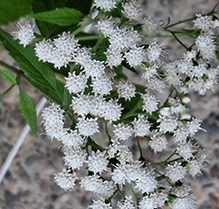 |
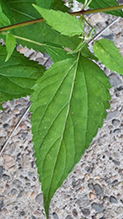 |
|
 |
 |
|
Here's another black-horned smoothtail taken a few days after the previous one I sent. 9/7/24. They must like the white snakeroot (it's spreading around the edge of the yard). |
Bee on white snakeroot. |
|
Kirk Nelson |
||
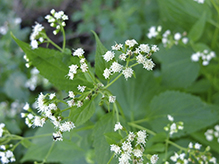 |
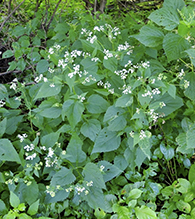 |
|
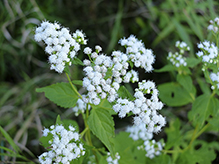 |
||
MinnesotaSeasons.com Photos
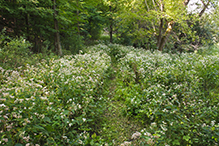 |
||
Habitat |
|
|
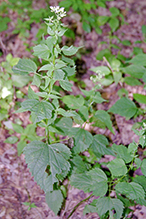 |
 |
|
Plant |
Plant |
|
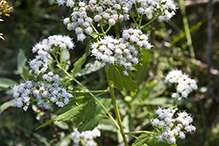 |
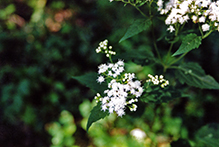 |
|
Inflorescence |
Inflorescence |
|
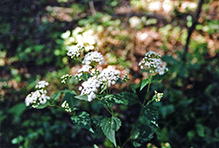 |
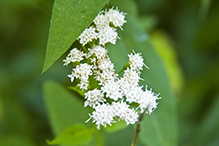 |
|
Inflorescence |
Flower heads |
|
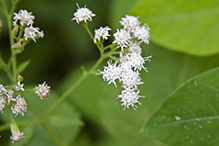 |
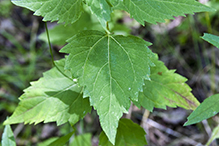 |
|
Flower heads |
Leaves |
|
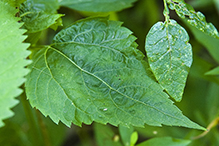 |
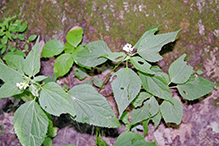 |
|
Leaves |
Leaves |

Slideshows
Ageratina altissima (White Snakeroot)
Allen Chartier

Visitor Videos
Share your video of this plant.
This button not working for you?
Simply email us at info@MinnesotaSeasons.com.
Attach a video, a YouTube link, or a cloud storage link.
Other Videos
Minnesota Native Plant - White Snakeroot (Eupatorium Rugosum)
MNNativePlants

Visitor Sightings
Report a sighting of this plant.
This button not working for you?
Simply email us at info@MinnesotaSeasons.com.
Be sure to include a location.
Luciearl
9/7/2024
Location: Lake Shore, MN
Here's another black-horned smoothtail taken a few days after the previous one I sent. 9/7/24. They must like the white snakeroot (it's spreading around the edge of the yard).
Brandon Artmann
8/28/2021
Location: near Scherman, MN
Abundant in our woods, near Scherman, MN, especially along wood edges.
Kirk Nelson
8/19/2017
Location: Fort Snelling State Park.
Along the edge of the woods near the beach parking area.
Minnesota Seasons Sightings
Bertram Chain of Lakes Regional Park
Carpenter St. Croix Valley Nature Center
Carver Highlands WMA, South Unit
Charles A. Lindbergh State Park
Clifton E. French Regional Park
Hardscrabble Woods / MG Tusler Sanctuary
John Peter Hoffman Spring Brook Valley WMA
Kellogg Weaver Dunes SNA, Kellogg Weaver Unit
Minnesota Valley NWR, Chaska Unit
Minnesota Valley NWR, Louisville Swamp Unit
Minnesota Valley NWR, Rapids Lake Unit
Mound Spring Prairie SNA, North Unit
Robert Ney Memorial Park Reserve
Sand Prairie Wildlife Management and Environmental Education Area






